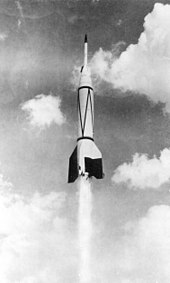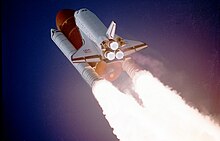Military
Arrow anti-ballistic missile launch
Science & research
A Bumper sounding rocket
See also: Space probe
 Sounding rockets are commonly used to carry instruments that take readings from 50 kilometres (31 mi) to 1,500 kilometres (930 mi) above the surface of the Earth, the altitudes between those reachable by weather balloons and satellites.[65]
Sounding rockets are commonly used to carry instruments that take readings from 50 kilometres (31 mi) to 1,500 kilometres (930 mi) above the surface of the Earth, the altitudes between those reachable by weather balloons and satellites.[65]Rocket engines are also used to propel rocket sleds along a rail at extremely high speed. The world record for this is Mach 8.5.[66]
Spaceflight
Space Shuttle Atlantis during launch phase
Main article: Spaceflight
Larger rockets are normally launched from a launch pad which serves as stable support until a few seconds after ignition. Due to their high exhaust velocity - 2,500 to 4,500 m/s (9,000 to 16,000 km/h; 5,600 to 10,000 mph) (Mach ~10+), rockets are particularly useful when very high speeds are required, such as orbital speed (Mach 24+[67]). Spacecraft delivered into orbital trajectories become artificial satellites which are used for many commercial purposes. Indeed, rockets remain the only way to launch spacecraft into orbit and beyond.[68] They are also used to rapidly accelerate spacecraft when they change orbits or de-orbit for landing. Also, a rocket may be used to soften a hard parachute landing immediately before touchdown (see retrorocket).


No comments:
Post a Comment